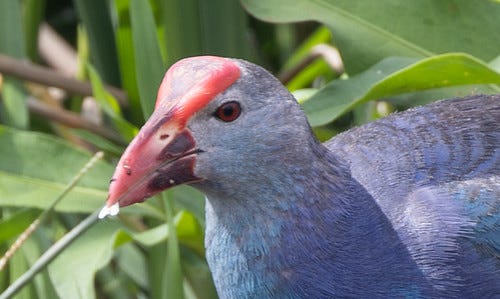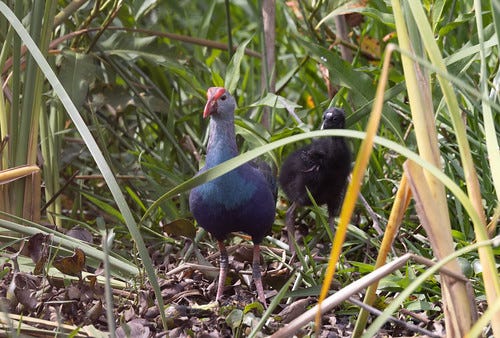(Listen to the radio version here.)
In the late 1990s, some Purple Swamphens escaped from an aviculturist somewhere around Pembroke Pines in South Florida. They belong to Porphyrio, the same genus as our native Purple Gallinules, but the swamphens are native to many tropical and subtropical areas throughout the world except the Americas.
South Florida was apparently to their liking, and the escapees increased and multiplied.
Swamphens eat mostly plants. In Florida, they feed on the abundant Gulf Coast spikerush (Eleocharis cellulosa) and a wide range of other plants including rice in the Everglades Agricultural Area and stormwater treatment areas, birdseed, and grass shoots. But they’re not strict vegetarians, taking advantage of animal protein when the opportunity arises. Swamphens elsewhere have been reported eating some birds, amphibians, reptiles, fish, eggs, insects, arthropods, and mollusks, but haven’t been studied enough in Florida for us to have a clear understanding of their diet, much less what kind of an impact they’re having on native plants and animals or if they’re competing with our native Purple Gallinules. From October 2006 through December 2008, Florida state agencies killed 3,187 swamphens, but this had no observable impact on the population. The swamphens in Florida need more study, but critical problems such as Burmese pythons, agricultural runoff, and development pose far more clear and present dangers.
The Purple Swamphen was added to Florida’s official checklist in 2013, the year I did my Big Year; I didn’t try to see one because my focus was on species that were in trouble, not exotics.
Meanwhile, in 2015, taxonomists concluded that this widespread Old-World bird was really a complex of six different species. The one found in Florida, native to the Middle East and the Indian subcontinent to southern China and northern Thailand, is now called the Gray-headed Swamphen.
A few weeks before my South Florida birding tour, I got invited to go to Kissimmee for four days, sponsored by groups hoping to raise awareness of the birds in the area. Because my son lives in Orlando, I spend a lot of time birding in Kissimmee, so I took advantage of this opportunity to discover new spots I wasn’t familiar with and to get more information to help me raise awareness of the rich birdlife that still exists in that over-developed part of Florida. What people don’t know about, they don’t even think about protecting.
I thought I’d seen just about every possible bird in central Florida, but nope, thanks to an experience I’d never considered doing before—an airboat ride through a park called “Wild Florida.” Most of it is a zoo, not a wild park, featuring animals that don’t live anywhere near Florida in the wild, such as sloths, giraffes, and zebras. But the airboat rides go into what are called the headwaters of the Everglades. Plenty of cattle, accompanied by Cattle Egrets, grazed in the drier parts of the marshland—Florida is among the top ten states for beef production—but we saw a fairly good assortment of birds in the wetter areas.
Airboats are extremely noisy. We were issued heavy-duty headphones to protect our hearing, so if any birds happened to be singing, there’s no way we could have heard them. The boats follow pretty much the same routes day after day, and stay in the water channels rather than slamming through the vegetation, so the birds that live there seem to have acclimated to them, though the marsh didn’t seem as rich in species as quieter areas around Kissimmee. The boat captain was very knowledgeable, accurately pointing out lots of birds including Limpkins and a Snail Kite. I saw a total of 39 species. I asked the captain if he ever saw swamphens there, and at that very moment he spotted one. And it wasn’t just one—it was a pair with a chick, and he took us by slow enough for me to get decent photos.
Crew on any kind of tourist boat focus on crowd pleasers rather than birds few people other than birders know, but many are pretty knowledgeable. Any time you take a cruise, make sure to tell the captain, ship’s naturalist, or someone on the crew that you are looking for wild birds. They might spot one or two excellent birds, and at the very least, you’ll raise awareness that customers value wild birds and habitat.
Riding in airboats or marsh buggies and tramping through marshes dragging ropes and shining spotlights were once standard birding practices in many areas so birders could flush and see rails and other secretive species, but birding ethics have eliminated the worst of these invasive, destructive, and often cruel practices. Whether in the service of birding or not, airboat noise keeps many birds at bay, and airboats bear a heavy carbon footprint, getting only about 2 miles per gallon. But they don’t have the lethal underwater propellors of other motorboats; many non-birding tourists, including members of birders’ families, enjoy them; and I have to admit I liked getting so close to several of the birds we saw, most especially those swamphens. And the fact that all the Limpkins and the two swamphen adults and their chick didn’t seem fazed by the airboat made it evident that in areas with regular airboat activity, some birds do adjust—at least where there are few or no alternatives. This was the first and probably the last time I’ll ever ride on one, but it was interesting and rewarding. Birders visiting Orlando with family but yearning to see some exciting birds might find an afternoon at Wild Florida something everyone can enjoy.
I’d originally expected to see my lifer swamphens on the Victor Emanuel South Florida birding tour. On that tour we saw them at just one place—the Wakodahatchee Wetlands on Delray Beach in Palm Beach County. There are other spots not too far from Orlando where they are becoming regular, like the Lake Apopka Wildlife Drive, but for birders spending a few days in central Florida with people who mainly want to visit theme parks, the airboat ride at Wild Florida may be one way to see this handsome newcomer.











Thank you, Laura! So glad I can support your posts!